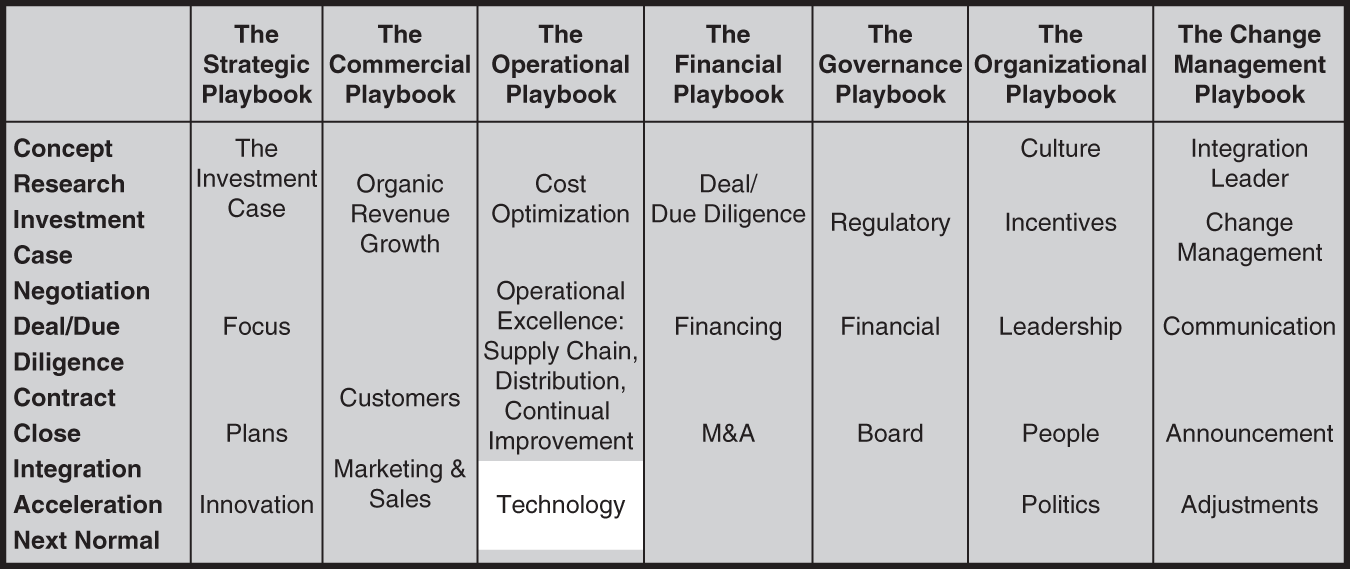CHAPTER 10
Technology: Because All Companies Are Technology Companies Today

The third component of the operational playbook is technology. While it's an important, stand-alone component on its own, it's even more important as a critical enabler of the first two components.
The machines rose from the ashes of the nuclear fire. Their war to exterminate mankind had raged for decades, but the final battle would not be fought in the future. It would be fought here, in our present.
James Cameron and Gail Hurd, The Terminator
The machines are winning.
Don't believe me? Then believe harmon.ie chief executive officer (CEO) Yaacov Cohen. He watches teenagers at birthday parties texting each other (on machines) instead of talking to each other. He notices his breakfast table where each family member is hiding behind their own device, enslaved by their machines. Movie theaters used to ask us not to smoke or talk. Now they ask us to turn off our machines.1
The machines are winning.
Today's technology is adding addictions, disrupting the workflow and making many of us less efficient and eff—(Sorry. Had to respond to a text message. But I'm back now.)—making us less efficient and effective.
This was not the hope. This was not the promise. This was not what we set out to do. It's time to make the technology work for us instead of letting the machines win.
Cohen has a different vision of what technology should do. His vision is one of technology augmenting relationships instead of reducing them, one of technology enabling collaboration instead of cementing silos. In his world, it acts as an intuitive aide instead of as a relentless disruptor. How?
His answer has three parts. Enable:
- Document sharing so everyone can work on the same document and see all the versions.
- Interaction via instant messages, text, voice over Internet, videoconference, and so forth.
- Sharing and interaction within whatever platform each individual user chooses.
Cohen and his harmon.ie team have designed a suite of connected apps to do just this while maintaining the right attitude to technology and machines.
Machine Strategy
Make sure you are leveraging technology to further your strategy. Your technology choices must help you win where it matters. Having the most advanced knowledge is merely a fleeting advantage. Technological superiority is not in itself a strategy; it's part of enabling a greater vision.
Machine Posture
Think through how technology aids you along the proactive-responsive scale. Do you need your technology to help you innovate and get ahead of your customers' needs? Or, do you need your technology to help you keep in touch with your customers so you can be responsive to needs they identify?
Machine Culture
Be conscious of how technology influences your behavior and relationships with others. If the technology is enabling your relationships, great. If the technology is allowing you to have a bigger impact than you would without it, great. If not, the machines are winning. And that's not acceptable.
BRAVE Technology
Apply the five BRAVE (behaviors, relationships, attitudes, values, environment) questions to your technology.
Where Play
As we've said, technology is an enabler. Leverage across your priority choices to improve effectiveness or efficiency in different situations.
- Look first at where you choose to win by being predominant or top 1 percent, superior or top 10 percent, or strong or top 25 percent. In these places, invest in technology to improve effectiveness. These should be your most leverageable technology investments with the return on investment (ROI) based on revenue acceleration.
- Then look at where you choose not to lose by being above average and competitive, or good enough and scaled. In these places, the technology investments should drive efficiencies with the ROI based on total cost reductions across the organization.
- Finally, look at where you choose not to do by outsourcing or not doing at all. In these places, you should not make any direct technology investments at all.
What Matters and Why
Scope is a function of resources and time:
If I need to move 10 boxes up a flight of stairs (scope) and there's one person capable of moving one box every 5 minutes (resources), it's going to take 50 minutes to move the boxes (time).
If I need them moved in a half an hour, I need two people.
Or a fancy technological solution called an elevator to enable one person to move all the boxes in 10 minutes themself.
What matters is technology's impact on effectiveness or efficiency.
How to Win
This is the pivot, figuring out the right technology. In the moving example, other technologies might have been pullies or ramps or magnets or giants.
How Connect
The technological solution never stands alone. Think SIPOC (supplier–input–process–output–customer) and the suppliers of inputs into the process so the outputs meet the needs of the next person in the customer chain. Don't guess at other capabilities, needs, and barriers. Ask them.
What Impact
And we're right back to the beginning. No one cares about the technology. They care about what the technology enables them to do.
Note
- 1 Bradt, George, 2013, “Make Technology Work for You or Else,” Forbes (January 16).
